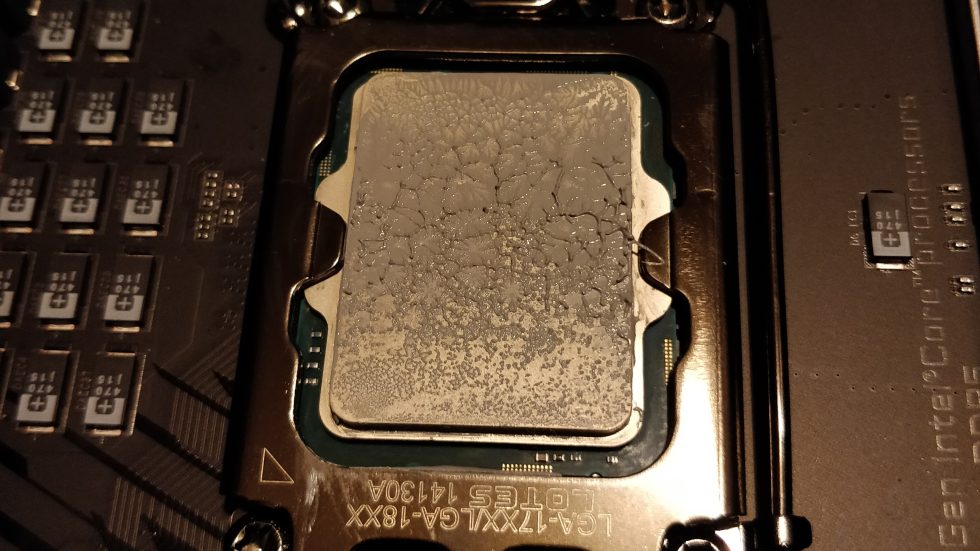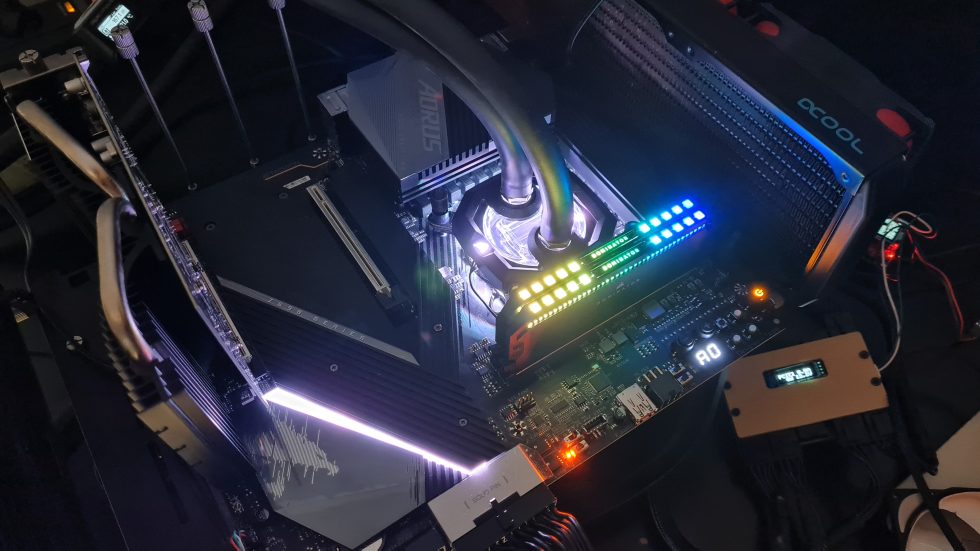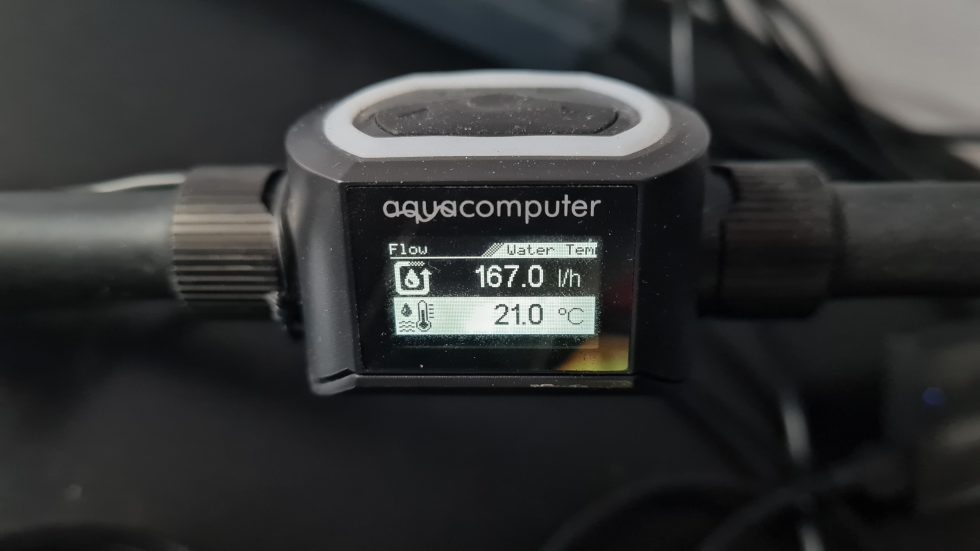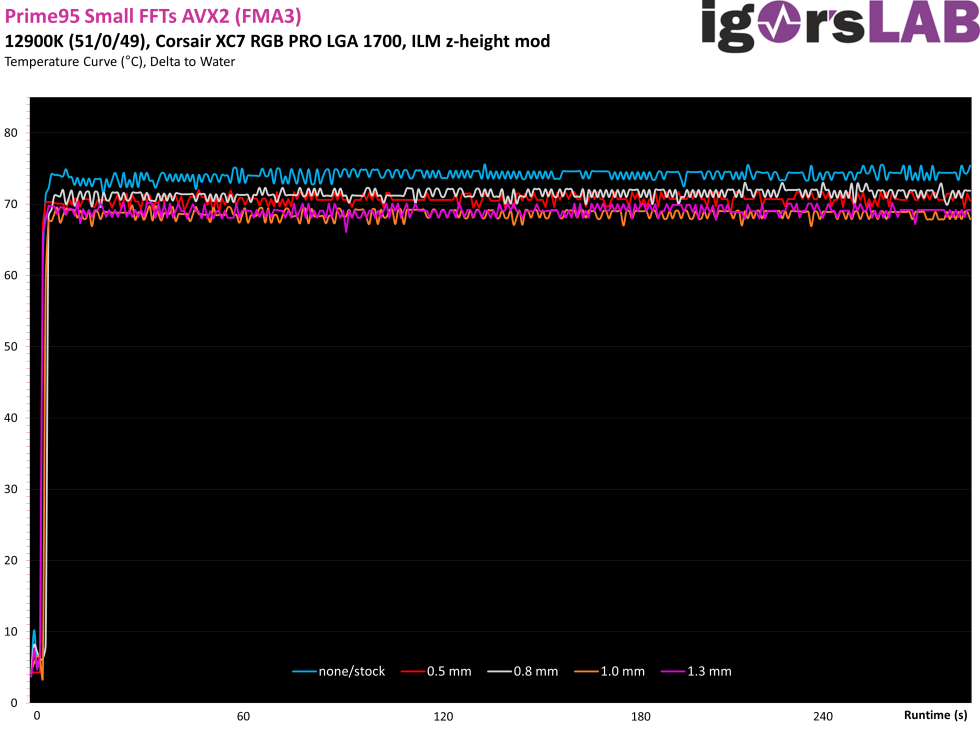Now it’s a matter of determining what measurable benefits the mod really provides and what thickness of washers will work best. An Intel Core i9-12900K CPU is used as the test system, which is run by the Gigabyte Aorus Z690 Tachyon motherboard at 5.1 GHz on the P-cores and 4.9 GHz on the ring or cache. E-cores and AVX-512 are disabled for the highest possible heat density in the CPU.
Cooling is provided by a Corsair XC7 RGB PRO LGA 1700 water block, which is integrated into my custom water cooling circuit on the testbench. Here 3 radiators provide the appropriate cooling and an Aquacomputer high flow NEXT reports via USB the flow rate and temperature of the water to the system, so we can form a reliable delta even without a constant water temperature.
The temperature of P cores and cooling water are logged by HWiNFO at intervals of 500 ms, so that for each core the temperature difference to the water and thus the quality of the cooling can always be evaluated. The maximum temperature that each core reaches is especially decisive for the CPU’s stability. The average of the maximum delta temperatures of the 8 P-cores will serve us as the primary comparison value for the different configurations. In addition, we collect the average temperature of all 8 P-cores at each measurement time and plot its delta to the water temperature over the period of the test run to better illustrate the differences. Prime95 with the Small FFTs preset and AVX2 (FMA3) for the highest possible heat load are used as the stress test, each in runs of 5 minutes.
As always, the rest of the test hardware used can be found here for review:
|
Test systems |
|
|---|---|
| Hardware: |
|
| Cooling: |
|
| Housing: |
|
| Periphery: |
|
| Measuring devices: |
|
In addition to the standard ILM, we tested washer thicknesses of 0.5 mm, 0.8 mm, 1.0 mm and 1.3 mm. 1.8 mm cannot be installed at all due to the shortness of the ILM screws. P# max Δ is in each case the highest temperature of a CPU core as a delta to the water temperature at the measured time. All values are given in degrees Celsius. And the result looks like this:
| Washer Config | P0 max Δ | P1 max Δ | P2 max Δ | P3 max Δ | P4 max Δ | P5 max Δ | P6 max Δ | P7 max Δ | Average | Improvement |
| none/stock | 69.5 | 82.5 | 73.7 | 86.6 | 75.0 | 83.6 | 73.7 | 74.8 | 76.64 | — |
| 0.5 mm | 66.4 | 79.1 | 70.2 | 83.7 | 72.3 | 79.0 | 69.3 | 70.7 | 73.84 | -2.80 |
| 0.8 mm | 67.1 | 77.9 | 70.2 | 82.6 | 72.3 | 78.4 | 70.2 | 70.5 | 73.65 | -2.99 |
| 1.0 mm | 63.9 | 74.8 | 67.2 | 79.3 | 69.3 | 77.4 | 67.0 | 68.1 | 70.88 | -5.76 |
| 1.3 mm | 64.2 | 75.2 | 68.1 | 80.1 | 70.2 | 77.9 | 68.1 | 69.0 | 71.60 | -5.04 |
With the stock socket, the P-cores average 76.64 °C more than the water, with P-core 3 always being the warmest on my two Chinese CPUs. If we now start testing with the washers, we already see an improvement of 2.8 °C with 0.5 mm and almost 3 °C with 0.8 mm. The best result can be achieved in our tests with a thickness of 1.0 mm with 70.88 °C and thus an improvement of 5.76 °C. The even higher 1.3 mm even regresses slightly to 71.60 °C, since the cooler base already rests slightly on the ILM here. We could not determine an impairment of the pin contacts in the socket and possible effects on the system stability in any case, even with overclocked DDR5 RAM.
If we plot the average temperature of all P-cores relative to water over time, we can see that the Intel socket without modification (blue here) always produces the highest temperatures. Here, the 0.5 mm is slightly below the 0.8 mm, although this depends on the point of view of the data (average versus maximum temperature). But even here, the 1.0 mm with the lowest temperatures of all tests can achieve the best result.
Conclusion
The fact that Intel CPUs are not always exactly flat is actually nothing new, but this usually manifested itself in a convex shape in the past, where the center of the CPU was highest. Thus, in the past, convex heat sinks were also able to achieve optimum contact and provide good cooling at least exactly at the critical point in the center of the IHS, with the poorer contact towards the edge being rather negligible due to the lower transfer heat there.
Now, unfortunately, Intel has literally turned the tables with Alder Lake, so the center of the IHS tends to sit lower than the surrounding area and only an extremely convex cooler base could make direct contact with the CPU there. In most cases, however, a lake of thermal paste simply forms in the center of the IHS without direct contact of the CPU and cooler. However, it is interesting that the CPUs are probably not (as strongly) concave from the factory as they are after installation in the socket and thus 4 washers between the ILM and the motherboard can already cause a significant improvement in the temperatures.

A 50 pack of M4 1.0 mm nylon washers can be had for under 5 Euros and getting 1 °C lower CPU temperatures for every single Euro invested in cooling is truly the dream of every enthusiast and overclocker. Nevertheless, the question arises, as so often, whether Intel really thought the construction of the base and ILM through to the end, or whether a more optimal solution could or even should have been found from the factory.
We are already investigating the topic further and are also testing, for example, whether the different LGA1700 socket brands (Lotes, Foxconn) have an effect on the optimal dimension for the washers, and whether CPUs might even be straight out of the box and our specimens have only permanently taken on some of the deformation due to the hundreds of operating hours since launch with various heat cycles. If you have ideas about which tests or data points would be of particular interest to you, feel free to let us know in the forum.
Thanks again to buildzoid, who gave us the idea for today’s test and let us publish the results first. If you are interested in overclocking and want to know e.g. how a VRM works or which voltage limits are recommended for a certain platform, you should definitely take a look at his channel and maybe leave a subscription!





































189 Antworten
Kommentar
Lade neue Kommentare
Veteran
1
1
Mitglied
Mitglied
Veteran
Mitglied
Veteran
Veteran
Mitglied
Veteran
Urgestein
Urgestein
Mitglied
Veteran
Veteran
Neuling
Urgestein
Alle Kommentare lesen unter igor´sLAB Community →